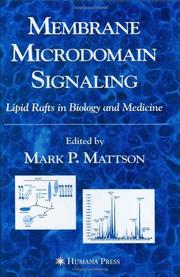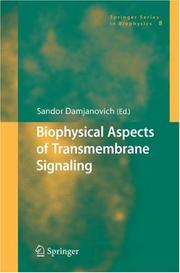| Listing 1 - 8 of 8 |
Sort by
|

ISBN: 0521330769 9780521330763 9780511546228 9780521177450 0511115857 9780511115851 0511122136 9780511122132 051154622X 1280153075 9781280153075 0521177456 1107141435 9786610153077 051119871X 0511299591 051111530X Year: 2005 Publisher: Cambridge New York Cambridge University Press
Abstract | Keywords | Export | Availability | Bookmark
 Loading...
Loading...Choose an application
- Reference Manager
- EndNote
- RefWorks (Direct export to RefWorks)
Meristematic cells in plants become the many different types of cells found in a mature plant. This is achieved by a selective response to chemical signals both from neighbouring cells and distant tissues. It is these responses that shape the plant, its time of flowering, the sex of its flowers, its length of survival or progress to senescence and death. How do plants achieve this? This treatise addresses this question using well-chosen examples to illustrate the concept of target cells. The authors discuss how each cell has the ability to discriminate between different chemical signals, determining which it will respond to and which it will ignore. The regulation of gene expression through signal perception and signal transduction is at the core of this selectivity and the Target Cell concept. This volume will serve as a valuable reference for all researchers working in the field of plant developmental biology.
Plant cellular signal transduction. --- Plant hormones. --- Plants --- Plant and Crop Sciences. Botany --- Development. --- Plant Development. --- Development of plants --- Plant development --- Developmental biology --- Growth (Plants) --- Cellular signal transduction --- Plant cellular control mechanisms --- Hormones (Plants) --- Phytohormones --- Hormones --- Phytochemicals --- Plant regulators --- Ontogeny

ISBN: 1280359161 9786610359165 1592599095 1588295257 1617376191 Year: 2005 Publisher: Totowa, N.J. : Humana Press,
Abstract | Keywords | Export | Availability | Bookmark
 Loading...
Loading...Choose an application
- Reference Manager
- EndNote
- RefWorks (Direct export to RefWorks)
Although inflammatory disease of the vascular bed of the lung is a major cause of morbidity and mortality in both adult and pediatric age groups, the importance of vascular biology to its understanding, and in developing novel therapeutics, has been overlooked. In Cell Signaling in Vascular Inflammation, leading basic and clinical researchers review the signal transduction mechanisms responsible for lung inflammation, including vascular hyperpermeability, white cell accumulation, and vascular remodeling. The authors cut across disciplines to bring together a broad-based presentation of inflammatory challenge, both in the initial phases of the inflammatory response, as well as in the more prolonged phase of genomic involvement. Authoritative and state-of-the-art, Cell Signaling in Vascular Inflammation offers physiologists, molecular and cell biologists, and pharmaceutical scientists a comprehensive survey of the signal transduction pathways in lung vascular cells that illuminates not only the processes of lung inflammation, but also the potential for developing new therapeutic strategies to combat inflammatory lung disease.
Vasculitis. --- Cellular signal transduction. --- Inflammation --- Mediators. --- Medicine. --- Vascular surgery. --- Medicine & Public Health. --- Vascular Surgery. --- Vascular surgery --- Clinical sciences --- Medical profession --- Human biology --- Life sciences --- Medical sciences --- Pathology --- Physicians --- Inflammatory mediators --- Mediators of inflammation --- Biomolecules --- Cellular information transduction --- Information transduction, Cellular --- Signal transduction, Cellular --- Bioenergetics --- Cellular control mechanisms --- Information theory in biology --- Angiitis --- Blood-vessels --- Vasculitides --- Diseases --- Surgery.
Book
ISBN: 3540271945 Year: 2005 Publisher: Berlin : Springer,
Abstract | Keywords | Export | Availability | Bookmark
 Loading...
Loading...Choose an application
- Reference Manager
- EndNote
- RefWorks (Direct export to RefWorks)
Recent advances have carried hepatology to new frontiers. The increasing frequency with which steatotic and cirrhotic livers undergo surgery obliges liver surgeons and hepatologists to understand the molecular mechanisms at play in these situations. Comprehension of the signaling pathways participating in liver regeneration, hepatocellular apoptosis and ischemia/reperfusion injury is essential. This book serves as a source of information to facilitate the reading of the literature and the planning of trials. Translational medicine implies knowledge of the molecular targets of novel therapeutic strategies. It is our goal to stimulate more research that can lead to more exchanges between the laboratory, the clinical ward and the operating room.
Liver --- Cellular signal transduction. --- Diseases. --- Cellular information transduction --- Information transduction, Cellular --- Signal transduction, Cellular --- Bioenergetics --- Cellular control mechanisms --- Information theory in biology --- Surgery. --- Clinical medicine. --- Gastroenterology. --- Surgical oncology. --- Internal medicine. --- Hepatology. --- Surgical Oncology. --- Internal Medicine. --- Cancer --- Oncologic surgery --- Oncological surgery --- Surgical oncology --- Internal medicine --- Digestive organs --- Medicine, Clinical --- Medicine --- Surgery, Primitive --- Medicine, Internal --- Excision --- Treatment --- Diseases --- Gastroenterology . --- Gastroenterology

ISBN: 9780199264674 0199264678 Year: 2005 Publisher: Oxford Oxford university press
Abstract | Keywords | Export | Availability | Bookmark
 Loading...
Loading...Choose an application
- Reference Manager
- EndNote
- RefWorks (Direct export to RefWorks)
Cell Communication --- 576.54 --- 576.54 Cell interaction. Communication --- Cell interaction. Communication --- Cell Interaction --- Cell-to-Cell Interaction --- Cell Communications --- Cell Interactions --- Cell to Cell Interaction --- Cell-to-Cell Interactions --- Communication, Cell --- Communications, Cell --- Interaction, Cell --- Interaction, Cell-to-Cell --- Interactions, Cell --- Interactions, Cell-to-Cell --- Cell interaction --- Cellular signal transduction --- Cells --- Acqui 2006

ISBN: 128071607X 9786610716074 0387260153 0387221301 9780387221304 Year: 2005 Publisher: New York : Springer,
Abstract | Keywords | Export | Availability | Bookmark
 Loading...
Loading...Choose an application
- Reference Manager
- EndNote
- RefWorks (Direct export to RefWorks)
A small number of signaling pathways, no more than a dozen or so, form a control layer that is responsible for all signaling in and between cells of the human body. The signaling proteins belonging to the control layer determine what kinds of cells are made during development and how they function during adult life. Malfunctions in the proteins belonging to the control layer are responsible for a host of human diseases ranging from neurological disorders to cancers. Most drugs target components in the control layer, and difficulties in drug design are intimately related to the architecture of the control layer. Molecular and Cellular Signaling provides an introduction to molecular and cellular signaling in biological systems with an emphasis on the underlying physical principles. The text is aimed at upper-level undergraduates, graduate students and individuals in medicine and pharmacology interested in broadening their understanding of how cells regulate and coordinate their core activities and how diseases arise when these regulatory systems malfunction, as well as those in chemistry, physics and computer science interested in pursuing careers in biological and medical physics, bioinformatics and systems biology. To that end, the book includes background information and review sections, and chapters on signaling in the immune, endocrine (hormonal) and nervous systems. It has chapters on cancer, apoptosis and gene regulation, and contains chapters on bacteria and viruses. In those chapters not specifically devoted to pathogens, connections between diseases, drugs and signaling are made. Each chapter also features a problem set to facilitate further discussion and understanding. About the Author: Martin Beckerman, Ph.D. is Senior Scientist at the Center forMartin Beckerman, PhD, is a senior research scientist at the Department of Energy/National Nuclear Security Administration’s Y-12 National Security Complex in Oak Ridge, TN. Prior to assuming his current position at the Y-12 NSC, Dr. Beckerman held teaching and research positions at the Weizmann Institute of Science, the University of Rochester, the Massachusetts Institute of Technology, the University of Tennessee and the Oak Ridge National Laboratory. He has authored over 130 publications and has been included in 1400 citations.
Cellular signal transduction. --- Cellular information transduction --- Information transduction, Cellular --- Signal transduction, Cellular --- Bioenergetics --- Cellular control mechanisms --- Information theory in biology --- Cytology. --- Medicine. --- Biomedical engineering. --- Biochemistry. --- Biological and Medical Physics, Biophysics. --- Cell Biology. --- Molecular Medicine. --- Biomedical Engineering and Bioengineering. --- Biochemistry, general. --- Biological chemistry --- Chemical composition of organisms --- Organisms --- Physiological chemistry --- Biology --- Chemistry --- Medical sciences --- Clinical engineering --- Medical engineering --- Bioengineering --- Biophysics --- Engineering --- Medicine --- Clinical sciences --- Medical profession --- Human biology --- Life sciences --- Pathology --- Physicians --- Cell biology --- Cellular biology --- Cells --- Cytologists --- Composition --- Health Workforce --- Biophysics. --- Biological physics. --- Cell biology. --- Molecular biology. --- Molecular biochemistry --- Molecular biophysics --- Biochemistry --- Biomolecules --- Systems biology --- Biological physics --- Physics --- Cellular signal transduction --- 577.35 --- 577.35 Biophysics of living systems --- Biophysics of living systems --- Biomedical Research. --- Research. --- Biological research --- Biomedical research

ISBN: 9781588293541 1588293548 9781592598038 9786610358243 1280358246 159259803X Year: 2005 Publisher: Totowa, N.J. : Humana Press,
Abstract | Keywords | Export | Availability | Bookmark
 Loading...
Loading...Choose an application
- Reference Manager
- EndNote
- RefWorks (Direct export to RefWorks)
Lipid rafts-discrete regions in cell membranes that are rich in cholesterol and sphingolipids-are emerging not only as pivotal command and control centers for cellular signaling processes, but also as central to a wide array of human diseases, including immune disorders, diabetes, cardiovascular disease, and Alzheimer's disease. In Membrane Microdomain Signaling: Lipid Rafts in Biology and Medicine, multidisciplinary experts offer cutting-edge reviews of our current understanding of these membrane microdomains and their physiological and pathological roles. Here, readers will discover how lipid rafts change in cells over time and how they respond to various environmental signals, how cholesterol modulates the signaling function of lipid rafts, and how lipid rafts, the extracellular matrix, and the cell cytoskeleton structurally interact. Also described are the role of lipid rafts in learning, memory, and cancer, and as portals for endocytic uptake of an anticancer- and apoptotic alkyl-lysophospholipid. The authors also present emerging evidence that lipid rafts play critical roles in signaling pathways and the regulation of synaptic function in the nervous system, and that alterations in lipid raft metabolism are implicated in the pathogenesis of neurodegenerative disorders. They also describe techniques for the isolation of lipid rafts, the analysis of the lipid and protein components of lipid rafts, the imaging of lipid rafts in living cells, and the analysis of signal transduction in lipid rafts. Comprehensive and insightful, Membrane Microdomain Signaling: Lipid Rafts in Biology and Medicine offers researchers a multidisciplinary review of the latest basic, translational, and clinical research that promises to transform our understanding microdomain signaling mechanisms.
Membrane Microdomains --- Apoptosis --- Lipids --- Signal Transduction --- Synapses --- Membrane lipids --- Cellular signal transduction --- Lipides membranaires --- Transduction du signal cellulaire --- pathology --- physiology --- metabolism --- Apoptosis. --- Cellular signal transduction. --- Membrane lipids. --- Metabolism --- Physiology --- Lipid Metabolism --- Pathology --- Biochemical Processes --- Nervous System --- Cell Membrane Structures --- Metabolic Phenomena --- Chemicals and Drugs --- Cell Death --- Cell Physiological Processes --- Medicine --- Intercellular Junctions --- Biological Science Disciplines --- Phenomena and Processes --- Natural Science Disciplines --- Biochemical Phenomena --- Cell Membrane --- Cell Physiological Phenomena --- Chemical Processes --- Health Occupations --- Anatomy --- Cellular Structures --- Disciplines and Occupations --- Chemical Phenomena --- Cells --- Cytology --- Animal Biochemistry --- Human Anatomy & Physiology --- Biology --- Health & Biological Sciences --- Cellular information transduction --- Information transduction, Cellular --- Signal transduction, Cellular --- Life sciences. --- Cell biology. --- Life Sciences. --- Cell Biology. --- Bioenergetics --- Cellular control mechanisms --- Information theory in biology --- Membranes (Biology)

ISBN: 9781588291721 1588291723 9781592598519 9786610358199 128035819X 159259851X Year: 2005 Publisher: Totowa, N.J. : Humana Press,
Abstract | Keywords | Export | Availability | Bookmark
 Loading...
Loading...Choose an application
- Reference Manager
- EndNote
- RefWorks (Direct export to RefWorks)
Cell death, or apoptosis, plays an important role in biological processes and disease and offers special opportunities to develop new therapies for cancer, autoimmune disease, stroke, heart attack, and Alzheimer's disease. In Death Receptors in Cancer Therapy, leading physician-scientists and basic researchers review in depth our latest understanding of the molecular events that regulate cell death, illuminating those molecules that provide targets for agonists or antagonists designed to modulate death signaling for therapeutic purposes. The authors focus on the extrinsic system of death receptors, their regulation and function, and their abnormalities in cancer. Topics of particlar interest include resistance to apoptosis, TRAIL signaling, death receptors in embryonic development, mechanisms of caspase activation, and death receptor mutations in cancer. Additional chapters address death signaling in melanoma, synthetic retinoids and death receptors, the role of p53 in death receptor regulation, immune suppression of cancer, and combination therapy with death ligands. Authoritative and up-to-date, Death Receptors in Cancer Therapy offers a timely compendium of cell death signaling pathways for those seeking either a basic understanding of apoptosis or the knowledge needed to develop new therapeutics that will activate or block death signaling in disease.
Neoplasms --- Cell Death --- Gene Therapy --- Receptors, Tumor Necrosis Factor --- Apoptosis --- Cell receptors --- Cancer --- Cellular signal transduction --- Apoptose --- Récepteurs cellulaires --- Transduction du signal cellulaire --- immunology --- therapy --- methods --- Molecular aspects --- Aspect moléculaire --- Kanker --- Kanker ; moleculaire aspecten --- Apoptosis. --- Cancer -- Molecular aspects. --- Cell receptors. --- Cellular signal transduction. --- Biological Therapy --- Genetic Engineering --- Diseases --- Investigative Techniques --- Cell Physiological Processes --- Receptors, Cytokine --- Cell Physiological Phenomena --- Receptors, Immunologic --- Analytical, Diagnostic and Therapeutic Techniques and Equipment --- Genetic Techniques --- Therapeutics --- Receptors, Cell Surface --- Phenomena and Processes --- Membrane Proteins --- Proteins --- Amino Acids, Peptides, and Proteins --- Chemicals and Drugs --- Methods --- Medicine --- Biology --- Health & Biological Sciences --- Cytology --- Oncology --- Molecular aspects. --- Cellular information transduction --- Information transduction, Cellular --- Signal transduction, Cellular --- Cell membrane receptors --- Cell surface receptors --- Receptors, Cell --- Medicine. --- Oncology. --- Medicine & Public Health. --- Tumors --- Clinical sciences --- Medical profession --- Human biology --- Life sciences --- Medical sciences --- Pathology --- Physicians --- Bioenergetics --- Cellular control mechanisms --- Information theory in biology --- Binding sites (Biochemistry) --- Cell membranes --- Cell death

ISBN: 1280304812 9786610304813 3540265112 3540250646 3642064116 Year: 2005 Publisher: Berlin : Springer-Verlag,
Abstract | Keywords | Export | Availability | Bookmark
 Loading...
Loading...Choose an application
- Reference Manager
- EndNote
- RefWorks (Direct export to RefWorks)
Transmembrane signaling is one of the most significant cell biological events in the life and death of cells in general and lymphocytes in particular. Until recently biochemists and biophysicists were not accustomed to thinking of these processes from the side of a high number of complex biochemical events and an equally high number of physical changes at molecular and cellular levels at the same time. Both types of researchers were convinced that their findings are the most decisive, having higher importance than the findings of the other scientist population. Both casts were wrong. Life, even at cellular level, has a number of interacting physical and biochemical mechanisms, which finally build up the creation of an "excited" cell that will respond to particular signals from the outer or inner world. This book handles both aspects of the signalling events, and in some cases tries to unify our concepts and help understand the signals that govern the life and death of our cells. Not only the understanding, but also the interference (e.g. medication) may depend on the full knowledge of both sides. These above statements are supported by the application of highly diverse physical and biochemical technologies demonstrated and explained by experts who are pioneers of their particular scientific field.
Cellular signal transduction. --- Bioenergetics. --- Energy balance (Biology) --- Energy budget (Biology) --- Energy dynamics (Ecology) --- Energy utilization (Biology) --- Biochemistry --- Energy budget (Geophysics) --- Cellular information transduction --- Information transduction, Cellular --- Signal transduction, Cellular --- Bioenergetics --- Cellular control mechanisms --- Information theory in biology --- Cytology. --- Biochemistry. --- Biological and Medical Physics, Biophysics. --- Cell Biology. --- Biochemistry, general. --- Biological chemistry --- Chemical composition of organisms --- Organisms --- Physiological chemistry --- Biology --- Chemistry --- Medical sciences --- Cell biology --- Cellular biology --- Cells --- Cytologists --- Composition --- Biophysics. --- Biological physics. --- Cell biology. --- Biological physics --- Physics
| Listing 1 - 8 of 8 |
Sort by
|

 Search
Search Feedback
Feedback About UniCat
About UniCat  Help
Help News
News